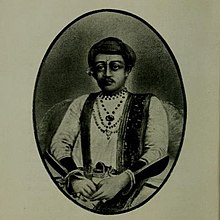This article has multiple issues. Please help improve it or discuss these issues on the talk page. (Learn how and when to remove these messages)
|
| Pratap Singh | |
|---|---|
| Maharaj | |
 | |
| Chhatrapati of the Marathas | |
| Reign | 3 May 1808 – April 1818 |
| Predecessor | Shahu II |
| Successor | Position abolished |
| Peshwa | Baji Rao II |
| Raja Chhatrapati of Satara | |
| Reign | 1818 – 5 September 1839 |
| Predecessor | Position established |
| Successor | Shahaji |
| Born | (1793-01-18)18 January 1793 Ajinkyatara Fort, Satara, Maratha Confederacy (present-day Maharashtra, India) |
| Died | 14 October 1847(1847-10-14) (aged 54) Benares, Benares State, British India (present-day Varanasi, Uttar Pradesh, India) |
| House | Bhonsale |
| Father | Shahu II |
| Mother | Girjabai Raje Bhonsale |
| Religion | Hinduism |
Pratap Singh (Pratap Singh Bhonsale, Marathi pronunciation: [prət̪ɑːpəsiⁿɦə ˈbʱos(ə)le]; 18 January 1793 – 14 October 1847) was the eighth and last Chhatrapati of the Maratha Confederacy from 1808 to 1818, when he surrendered to the British during the Third Anglo-Maratha War. He was also the Raja of Satara from 1818 until 1839, when he was replaced with Shahaji of Satara by the British.
Descent
He was born in the Bhonsle dynasty that were of the Bhonsle clan and Maratha caste.
Early life
Pratap Singh was the eldest son of Shahu II of Satara, whom he succeeded, and a descendant of Chatrapati Shivaji, the founder of the Maratha Empire.
Raja
After signing a treaty with East India Company in 1818, he ruled as the Raja of Satara from 1818 until 1839, when he was replaced with Shahaji of Satara by the company. On being dethronned the company in 1839, he was exiled to Benares and granted an allowance for his maintenance. Rango Bapuji Gupte, a loyal Sardar to him, long fought unsuccessful legal battles in London on his behalf.
He was succeeded by his brother, Appa Saheb, under the title Shreemant Maharaj Shaji Raja Chhatrapati of Satara. Appa Saheb then became known as Raja Shahaji.
Reign
References
- Kulkarni, Sumitra (1995). The Satara Raj, 1818-1848: A Study in History, Administration, and Culture. Mittal Publications. p. 29. ISBN 978-81-7099-581-4.
- ^ Kulkarni, Sumitra (1995). The Satara Raj, 1818-1848: A Study in History, Administration, and Culture. Mittal Publications. pp. 21–24. ISBN 978-8-17099-581-4.
- Sarkar, Jadunath (1992). Shivaji and His Times. Orient Longman. ISBN 9788125013471.
- Kulkarni, Sumitra (1995). The Satara Raj, 1818-1848: A Study in History, Administration, and Culture. Mittal Publications. p. 29. ISBN 978-81-7099-581-4.
Further reading
- Naregal, Veena (2013). "The Mutiny in Western India: The 'Marginal' as Regional Dynamic". In Bates, Crispin (ed.). Mutiny at the Margins: New Perspectives on the Indian Uprising of 1857. Vol. 1. SAGE Publications India. pp. 169–188. ISBN 978-8-13211-336-2.
| Preceded byShahu II of Satara | Chhatrapati of the Maratha Empire 1808–1818 |
Succeeded byLapsed |
| Preceded byNew creation | Raja of Satara 1818–1839 |
Succeeded byShahaji |
This biography of a member of an Indian royal house is a stub. You can help Misplaced Pages by expanding it. |